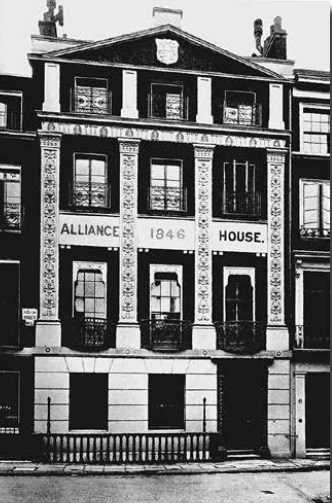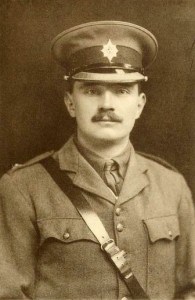Thank you to Mickleham and Westhumble Local History Group for allowing Dorking Museum to publish their research. Thank you to Jane Anthony from Dorking Museum for additional research. Thank you to Giles Morgan, great grandson of Bernard Salway Grissell for additional family information.
Francis Grissell was the fourth son of Thomas De la Garde Grissell and his wife Frances Adelaide. Francis was born in 1886 in Mickleham and baptised at St. Martin’s Church, Mickleham.
After being educated at Harrow, where he was a member of Newlands House he attended the Royal College of Art and was articled to Messrs Nicholson and Corlette Architects; renowned Church architects. Francis was elected ARIBA in 1913, and accepted a three year position in Hong Kong before returning to England on 26th June 1915, aboard the “Miyazaki Maru”. Francis Grissell made a bequest to the Royal Institute ‘to be used for the benefit of the library’ before leaving England.
Initially he enlisted in the Artists Rifles, which in 1915 effectively became an Officers Training Corp. Later the same year he was commissioned into the Coldstream Guards (4172).
At the beginning of September 1916 the 1st Battalion of the Coldstream Guards was based at Morlancourt, about 7km south of Albert, where they spent a week in training and practising for an attack on enemy trenches.
On 9th September the battalion marched to billets in ‘Happy Valley’, which acquired its name because it could not be seen from the German front lines. Five days later the battalion arrived at Ginchy, about 2 km south of Flers and close to Delville Wood, in preparation for a major attack the following morning. This offensive from 15th to 22nd September became known as the Battle of Flers-Courcele e and was the first me that tanks were used in large numbers in battle, heralding a new era in warfare. However, the two tanks that should have been at the front of the 1st Battalion’s attack never arrived. The battalion suffered heavy losses and the Harrow Memorial states that ‘he (Lieutenant Grissell) was killed by a German hand-grenade after reaching the second objective in the Guards’ advance.’ The war diary reports that on 15th September ‘the Battalion went into attack with 17 officers and 690 other ranks and came out with 3 officers and 221 other ranks’.
Francis Grissell’s body was never recovered and he is commemorated on the Thiepval Memorial along with 72,000 other men.
The action in which Grissell fell on 15th September 1916 was fought out near Ginchy on the Somme, the Coldstream Guards sustaining casualties of 40 Officers and 1326 other ranks.
The engagement was subsequently featured in The Illustrated London News of 18 November 1916, an artist’s impression of the Coldstreamers (or “Lily Whites”) pressing forward under heavy machine-gun fire being accompanied by the following text.
‘Several regiments of Guards, including the Coldstreams, the Grenadiers and the Irish, played a splendid part in the great battle of September 15, which resulted in the capture of Martinpuich and Courcelette and over 2300 prisoners. Our artist’s drawing has been made from an officer’s material just to hand. The ground in front of the German trenches, he says, was nothing else but shell-holes. There were three broken trees standing out above the mist, by which the line advanced. Originally they started shoulder to shoulder with bayonets at the charge in the good old style. Describing the same event, Mr. Philip Gibbs writes: ‘The Guards had their full share in the fighting … These splendid men so tall and proper, so hard and fine, went away as one might imagine the old knights and yeomen of England at Agincourt. For the first time in the history of the Coldstreamers, three battalions of them charged in line, great solid waves of men, as a fine a sight as the world could show. Behind them were the Grenadiers, and, again behind these men the Irish. They had not gone more than 200 yards before they came under the enfilade fire of massed machine-guns … Gaps were made in the ranks, but they closed up. The wounded did not call for help, but cheered on those who swept past and on, shouting “Go on, Lily Whites” – which is the name for the Coldstreamers – “get at ’em Lily Whites!” … the Guards went on. Then they were checked by two lines of trenches, wired and defended by machine-guns and bombers … The Guards took them by frontal assault full in the face of continual blasts of machine-gun bullets. There was hard and desperate fighting. The Germans defended themselves to the death … By that time the Irish Guards had joined the others. All the Guards were together, and together they passed the trenches … going steadily deeper into the enemy country until they were 2000 yards from their starting place … They fought grandly.’
Lieutenant-Colonel J. V. Campbell, D.S.O., of the 3rd Battalion, Coldstream Guards, who rallied his Guardsmen with a hunting horn, and led them to the sunken road (Flers Road), was awarded a well-deserved V.C.
In 2004 Francis Grissel’s medals were sold with others from his family including a copy M.C., G.V.R. and 1914-15 Star trio, the latter with erased naming, mounted as worn, with related set of dress miniatures, in old leather case, the whole attributed to the recipient’s brother, Lieutenant-Colonel T. de la G. Grissell, Suffolk Yeomanry, attached Suffolk Regiment.

At the time of his death, according to his probate record, Francis was living at 7 Adam Street, Adelphi, Middlesex. This area near The Strand, in what is now Central London, was designed by Robert Adam and his brothers in the early 1770s and Francis, as an architect, must have appreciated the characteristic Adam style.
In his will, he left an estate of over £53,000, of which £500 was bequeathed to the Library at the RIBA. He was not married and had no children.
More information on the Grissell family can be found on Bernard Salway Grissell‘s page
| Born | Mickleham, Surrey | |
| Lived | Mickleham, Surrey | |
| Son of | Thomas De la Garde and Frances Adelaide Grissell | |
| Brother of | Lieutenant Colonel Bernard Salway Grissell | |
| Regiment | Coldstream Guards | |
| Number | 4172 | |
| Former Regiment | Artists Rifles | |
| Date of Death | 15th September 1916 | |
| Place of Death | Somme, France | |
| Cause of Death | Killed in Action | |
| Age | 30 | |
| Memorial | Thiepval Memorial |
Dorking Museum is very grateful to the following members of Mickleham and Westhumble Local History Society for allowing the Museum to publish their research on the WW1 project; Paul Brown; Roger Davis; Caroline Freuler; Judy Kinloch; Judith Long; Phil Randles; Veronica Randles; Sue Tatham and Fiona Taylor. Thank you also to Ben Tatham and Andrew Tatham.


